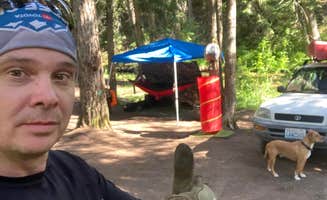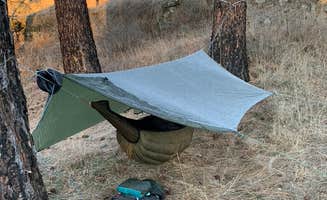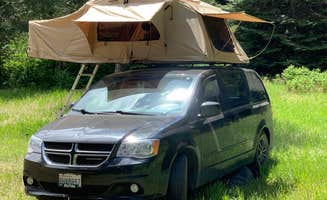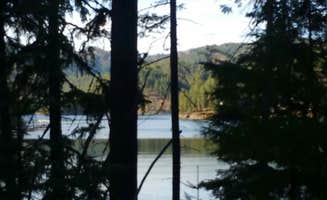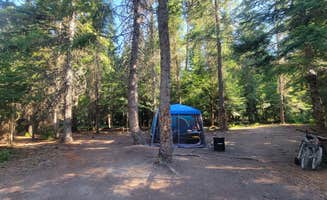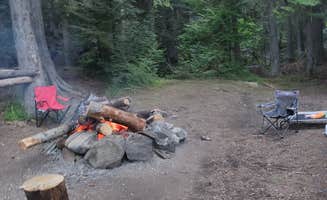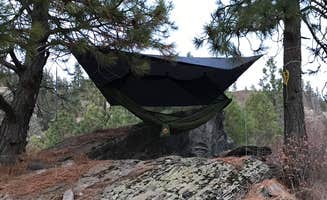Primitive camping near Ford, Washington typically includes sites on U.S. Forest Service and Bureau of Land Management (BLM) lands within a 45-minute drive. This northeastern Washington region sits at elevations between 1,600-2,800 feet, creating varied terrain from open prairie to dense pine forest. Summer temperatures often reach 85-95°F during July and August, while spring camping brings temperatures between 45-70°F with occasional rain.
What to do
Fishing opportunities: At Hog Lake Campground, the lake access provides good fishing during spring months. "The lake is a short hike depending where you pitch your camp," notes a visitor who appreciated the cooling water on hot days.
Hiking trails: Fishtrap Recreation Area offers hiking trails directly from the camping area. "There's also a trail that connects off the lot," reports one camper who enjoyed the trail system while staying overnight in an RV.
Wildlife viewing: The Little Pend Orielle Campground provides opportunities to observe diverse wildlife. "Birds everywhere, woodpeckers in the birch trees and killdeer darting down to the water. Chipmunks and rabbits. Tadpoles and turtles and little water snakes," one camper observed during their stay.
Creek exploring: Many dispersed sites offer creek access for cooling off. "The creek is very small but powerful. You can not swim but still a great place to get wet. If you have a tube bring it and enjoy a short river ride," notes a camper at North Fork Chewelah Creek.
What campers like
Proximity to water: Campers appreciate sites near lakes and creeks. At Cooks Lake, "the water was warm and we swam all day. Bats at night, and the stars!!" One visitor enjoyed having their tent just 12 inches from the water's edge.
Privacy between sites: The spacing between dispersed sites is frequently mentioned as a positive feature. "There were several quality spots... The spots we saw were all quite large and they are very spread out from each other," notes a camper who stayed at the Little Pend Orielle Campground.
Established fire rings: Most primitive sites come with fire rings. At North Fork Chewelah Creek, "There are established stone fire pits or you can gather up some rocks and make your own. Plenty of deadfall and fire wood all over the place."
Night sky viewing: The limited light pollution creates excellent stargazing opportunities. "Beautiful night sky. Very low traffic, we only saw two vehicles after dark," reports a visitor to Hog Lake Campground.
What you should know
Road conditions: Most dispersed camping areas require navigating unpaved roads. "The road to get there was approx six miles of gravel winding single lane road. But so worth the drive for the beautiful shaded sites and the open Lakeview sites," notes a camper at Cooks Lake.
Bathroom facilities: Toilet facilities at primitive sites are basic or nonexistent. At Fishtrap Recreation Area, "There is trash dumpster and 1 porta potty that when we were here was kinda gross. Use your own if you have one."
Limited connectivity: Cell service is unreliable at most primitive sites. "Not even any cell phone reception," reports a camper at Little Pend Orielle Campground, emphasizing the need to bring a GPS and have good map reading skills.
Seasonal restrictions: Fire bans are common during summer months. "A good spot to stay a night or more. Currently NO FIRES due to high risk of forest fires," notes a Hog Lake visitor during dry conditions.
Waste management: All sites require pack-in, pack-out practices. "The island's soil isn't deep enough for proper burial," advises a visitor to Bonnie Lake Island, recommending sanitary bags to pack out human waste.
Tips for camping with families
Beginner-friendly options: Some locations offer easier access for first-time dispersed campers. "First time taking the godson camping and this was the perfect spot," shares a camper about their experience at North Fork Chewelah Creek, noting the availability of a clean vault toilet in the area.
Swimming access: For families seeking water activities, select sites with gentle water entry. "The godson loved it - he even played in the freezing cold water," mentions a North Fork Chewelah Creek camper whose young companion enjoyed the creek despite cold temperatures.
Wildlife education opportunities: Cee Cee Ah Creek and surrounding areas provide chances to observe wildlife safely. "Hearing the birds was really cool," notes a camper who appreciated the natural soundtrack of the area.
Fishing with kids: Several lakes are stocked with rainbow trout. "There is a family friendly fishing dock on Potters pond, and it is stocked with good sized rainbow trout the little kids had a blast fishing," reports a visitor to Little Pend Orielle.
Tips from RVers
Site selection: Finding level spots suitable for trailers requires advance planning. "We have a 21ft trailer towed behind a pickup truck and it's able to fit in most spots. None of these are really official spots (not flattened or bordered) but it's a nice place to pass through," advises an RVer who stayed at Hog Lake.
Road navigation: RVers should assess road conditions before attempting access. "Road is a little bumpy but worth the drive in once you find your spot. There are several, very large, pull offs perfect for your stay," shares a visitor to Hog Lake.
Parking surfaces: Most areas feature natural, unimproved parking spots. "It's a fine large gravel pull out. I did see 3 little spots on the way in as well. No shade and it's windy. Almost lost my canopy," warns a visitor to Fishtrap Recreation Area.
Weekday timing: For easier site selection with larger vehicles, weekday arrivals are recommended. "Quite a few spots available. It is quite open with no tree so not so great for windy days," notes a Hog Lake visitor who found the area accessible but exposed.


